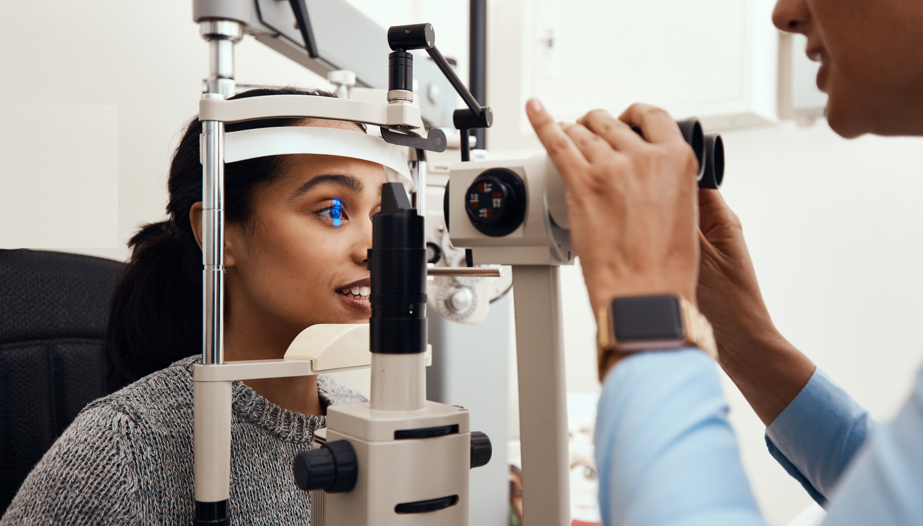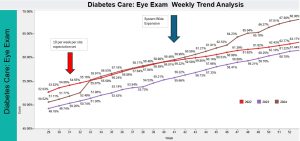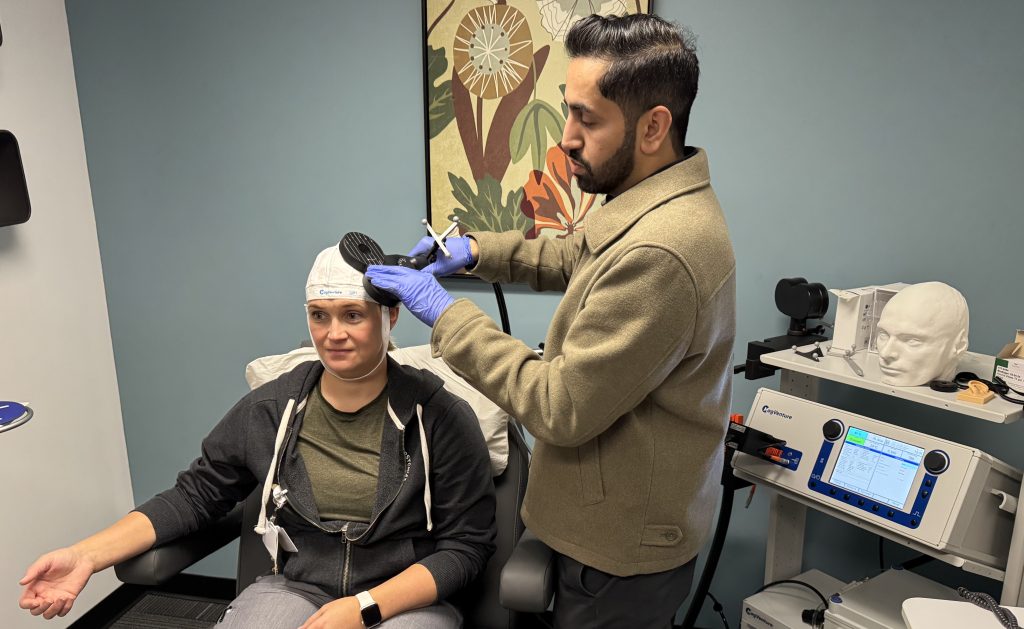New sight-saving AI-enhanced technology now available in 28 Sutter primary care offices; more locations will be added this year.
Eye exams are an annual necessity for people diagnosed with diabetes. The yearly test is the only way to screen for a condition called diabetic retinopathy – a consequence of diabetes that can lead to blindness if not caught early. But, in the past, getting an eye exam has been inconvenient and nearly half of those who needed one didn’t get it.
“In the traditional exam your eyes are dilated, which meant you couldn’t drive or work for hours after, and that held a lot of people back,” says Paul McFall, director of quality and patient safety at Sutter Health. Access was also a problem as only Optometrists or Ophthalmologists could perform the traditional exam. These eye specialists are concentrated in cities, presenting a transportation barrier for patients from rural areas. Add in appointment scarcity, unpredictable insurance coverage, and other hurdles inherent in seeing a new provider (like language differences), and it’s easy to see why many patients never made it to an appointment.
Advancements in the field of photography created an alternative. Small, easy-to-use cameras could photograph a patient’s retina, without dilation. The digital image could then be ‘read’ by an Optometrist or Ophthalmologist to detect (or hopefully rule out) retinopathy. Many in the medical community started using these cameras but stopped after they realized that sending the images out to be read created costs, delays and extra administrative work. Fast forward a few years, and Artificial Intelligence is now poised to solve these problems.
AI, when paired with so-called ‘retinal’ cameras, can now detect even the earliest signs of retinopathy in an eye image, in under 60 seconds. No human review needed.
Sutter’s Institute for Advancing Healthy Outcomes recently initiated a pilot to test if AI-enhanced cameras – used in primary care – could finally overcome long-standing access barriers and help more people with diabetes get their annual eye exam. Key to the intervention: offering the camera-based exam to any patient in need, regardless of what originally brought them to their primary care provider’s office.
“Like diabetes itself, rates of diabetic retinopathy are higher in patient groups that have poor access to care,” says Andy Brothers M.D., a Sutter family medicine physician and co-chair of the Physician and Advanced Practice Clinician Ambassador Council, within Sutter’s Institute for Advancing Healthy Outcomes. “So, we focused on access and convenience; this meant both making the eye exam available in-office and offering it to anyone who needed it, regardless of the reason for their visit.”
Initially, Dr. Brothers’ clinic in Sacramento was the only pilot site. But, with the help of Sutter’s Quality Improvement team, Center for Health Services Research, physician and nurse leaders, an additional five sites were quickly added.
Read more about the original inspiration for the pilot, and the people who led it, here.
In total, six primary care locations across Sutter’s not-for-profit network were equipped with the EyeArt® system, developed by Eyenuk, Inc. The pilot sites were located in cities with different densities, from urban Sacramento to rural Auburn and Yuba City, CA. Remaining sites were in the midsize cities of Antioch, Santa Rosa and Elk Grove, CA. Payor mix at each of the sites was different too, Sacramento seeing the highest percentage of patients insured through MediCal (California’s Medicaid program) at 15% of the practice panel.
The six-site pilot was in full swing from July 1st through September 30th, 2024 and was expected to end soon thereafter. But all six sites continue to use the technology today, giving Sutter teams prospective and retrospective data sets by which to analyze the success of the intervention.
The prospective data source, a meticulous daily count of eye exams performed in-office using the AI-enhanced cameras, totaled 216 exams across the six sites, during the three-month pilot. Of those, 24 showed some degree of retinopathy; 15 were graded “sight threatening” and nine were graded “more than mild.” All patients with a positive result were referred to an Ophthalmologist for follow-up.
Sutter’s EHR provided the retrospective data source, by logging every diabetic eye exam ‘health maintenance gap’ that was closed, either because an exam was performed in-office by camera or because the office received the result from a traditional exam done by an outside Optometrist or Ophthalmologist. A total of 235 diabetic eye exam ‘health maintenance gaps’ were closed over the three-month pilot period, across the six sites. The difference between the prospective and retrospective data sets indicates that as few as 19 patients received an eye exam from an Optometrist or Ophthalmologist during the pilot period. Stated differently, over a three-month timeframe, 92% of completed eye exams were those performed in a primary care provider’s office, using the AI-enhanced cameras.
“This data is dramatic, but it’s consistent with what I’ve seen in practice,” says Dr. Brothers. “Before we had retinal cameras in primary care, many patients didn’t go to the Optometrist or Ophthalmologist for their recommended eye exam and those that did would trickle in their result, sporadically. Contrast that to what we’re doing now – which you could describe as a warm transfer to walk-in availability – and I’m not surprised there was a nearly 12-fold increase in diabetic eye exams.”
Over a longer period of time the retrospective data, which includes a mix of in-office eye exams by camera and outside eye exams by specialist, gets even more interesting.
- During the month of June 2024, before the pilot took off, the Elk Grove practice closed 13 diabetic eye exam health maintenance gaps. In contrast, the same site closed a total of 174 of those gaps from the start of July to the end of December 2024 (an average of 29 per month). Elk Grove also achieved the highest one-month total (49 eye exam gaps closed in November, followed by 44 in December) and biggest difference between one-month totals, pre and post pilot (low of 13 in June to a high of 49 in November).
- Antioch had a drastic increase as well, going from closing just a single diabetic eye exam health maintenance gap in June 2024 to closing 100 during the last half of the year (an average of 17 per month).
- Plumas also stood out for its improvement. In June 2024 the site closed 7 diabetic eye exam health maintenance gaps but over the next six months it closed 93 (an average of 15 per month).
“As impressive as the site-by-site data is, the bigger story the enterprise-wide adoption and the difference it’s made,” says Dr. David Kerr, a Sutter expert on the role of technology and digital health in diabetes care. With the successful pilot as proof of concept, Sutter started to scale the AI-enhanced cameras across the system in late October 2024. By the end of January 2025, a total of 28 primary care practices across in the network were using them. The cumulative effect was sizable and swift. “In the past, Sutter typically had a recent diabetic eye exam result on file for about 62% of patients who need the test. In 2024 that compliance score jumped to 68% and we’re aiming to exceed 72% by the close of this year,” says Dr. Kerr.
“This project not only demonstrates Sutter’s commitment to expanding access, meeting patients where they are, and removing friction from the healthcare experience; it shows the positive result that these changes can have,” says Kristen M.J. Azar, R.N., MSN/MPH, Ph.D., Executive Director of Sutter’s Institute for Advancing Healthy Outcomes. “It’s also a great example of how a relatively small pilot can lead to big impact.”
Azar goes on to say that this work reinforces the idea that access improvement is quality improvement. “When we think about outcomes, in many cases it all starts with access, so that’s the perfect place to focus an intervention,” she says.
Follow-up work by Sutter may test outreach strategies to boost eye exam rates even higher. Just what you’d expect from an organization with the motto: ‘better never stops.’






